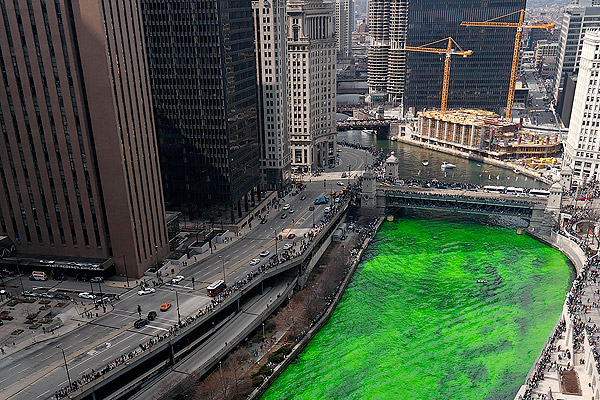
Confession: my first March in Chicago, a friend and I went to see the dyeing of the Chicago River for St. Patrick's day. We looked down, saw a green the color of a filthy Army rucksack, and were confused. It was only when we followed the crowds that we saw the irrepressable nuclear green and the accordingly decked out crowds gaping at it. If a three-eyed cartoon fish leapt out, I wouldn't have been surprised.
But the city's famous tradition actually comes from a moment of inspiration that occurred when the city began to clean up its quasi-river, quasi-sewer. During a massive development boom that included the construction of Marina City, the city began taking steps to clean up the river, including riverbank beautification and an apparently failed experiment in artificial aeration: "it might work like a paddle wheel. It might whirl above the water," Metropolitan Sanitary District chief engineer Burton A. Scheidt told the Tribune. "And it might look like a Rube Goldberg contraption." In 1962, this push to damper the river's stink crossed paths with Stephen Bailey, a first-generation Irish-American from Bridgeport, general chairman of the then-six-year-old parade, friend of Daley—he grew up two blocks from the mayor on Lowe Avenue—and labor leader:
It all began in Bailey's office when he saw a plumber whose white coveralls had been part of a crew pouring green dye into the city's waste systems to trace the flow of waste discharges. "Then," the plumber explained, "we check at the river's edge to see where the water is turning green."
Turning the water green! "Eureka," exclaimed Bailey, and the next day [parade coordinator Dan] Lydon and Chicago Port Director John Manley and his deputy, Bill Barry, were busy dumping a concoction of vegetable dye into the Chicago River. At first the result was a stream of vivid orange, leading Manley to exclaim "The Orangemen have outdone us!" But when the whirling propellers of their motorboat began to whip the preparation like a giant Mixmaster, the water finally took on a lovely shade of green.
One hundred pounds of the stuff was dumped that day into the water, and the river kept its green look for a week. After a series of yearly trial-and-error experiments, the current 40-pound formula was developed to produce a perfect hue of green that lasts four or five hours.
The Orangemen, or at least the handful that Irish visitor Wendy Martin could find for the Tribune in 1973, were apparently none too happy; the one northern Irish protestant she could find to go on the record called it "pollution."
Bailey didn't stop there, or at least tried not to. In 1965, he proposed painting the Wrigley building with "easily removable" green dye. He was denied the pleasure. "I don't think P.K. [Wrigley] likes the Irish," he told the Trib.
How it's done:
Photograph: hans (lumilux.org) (CC by 2.0)



Comments are closed.